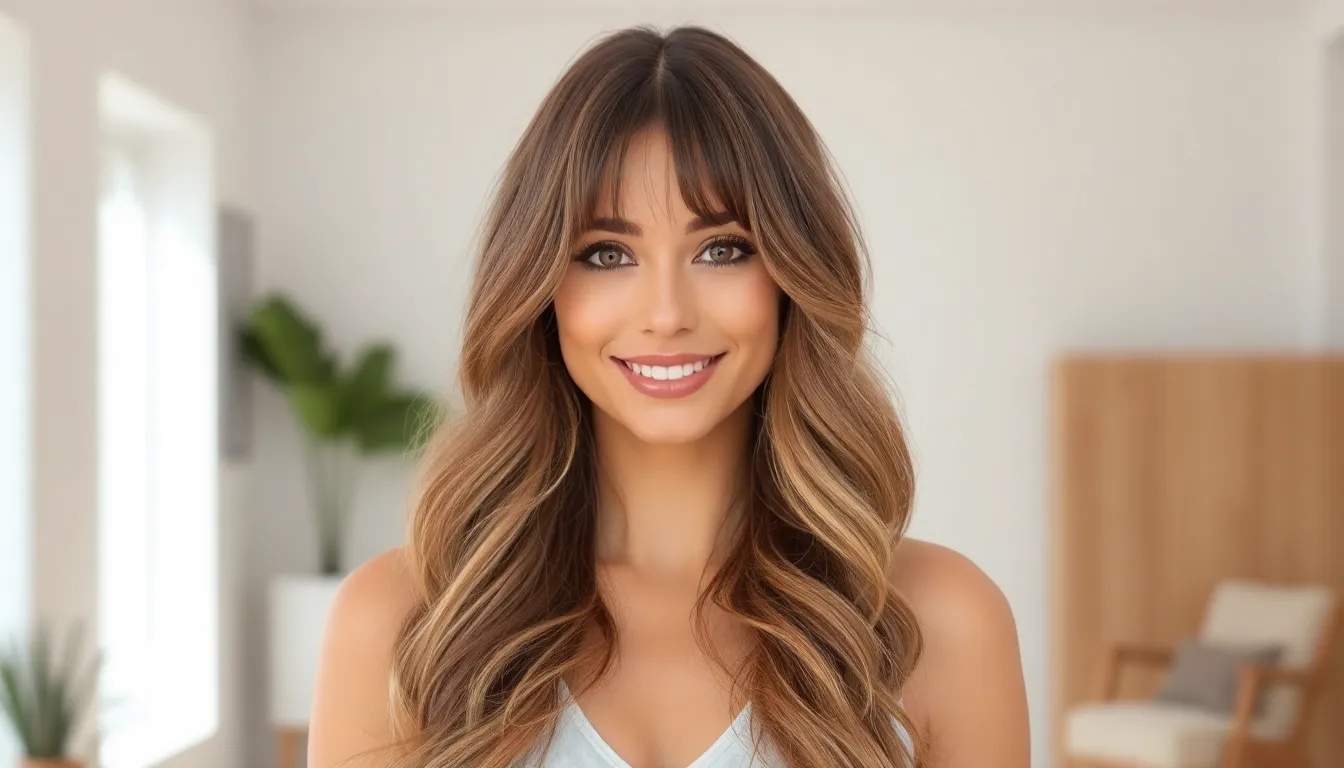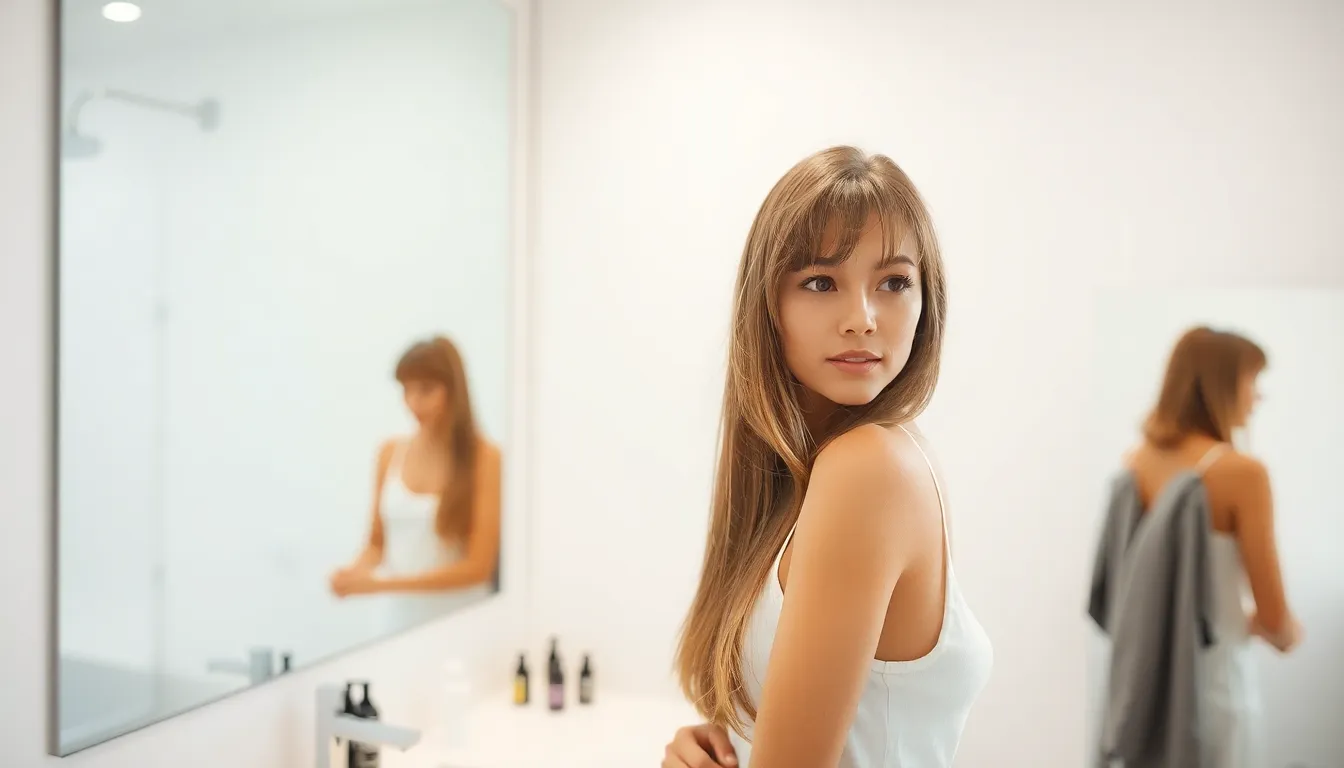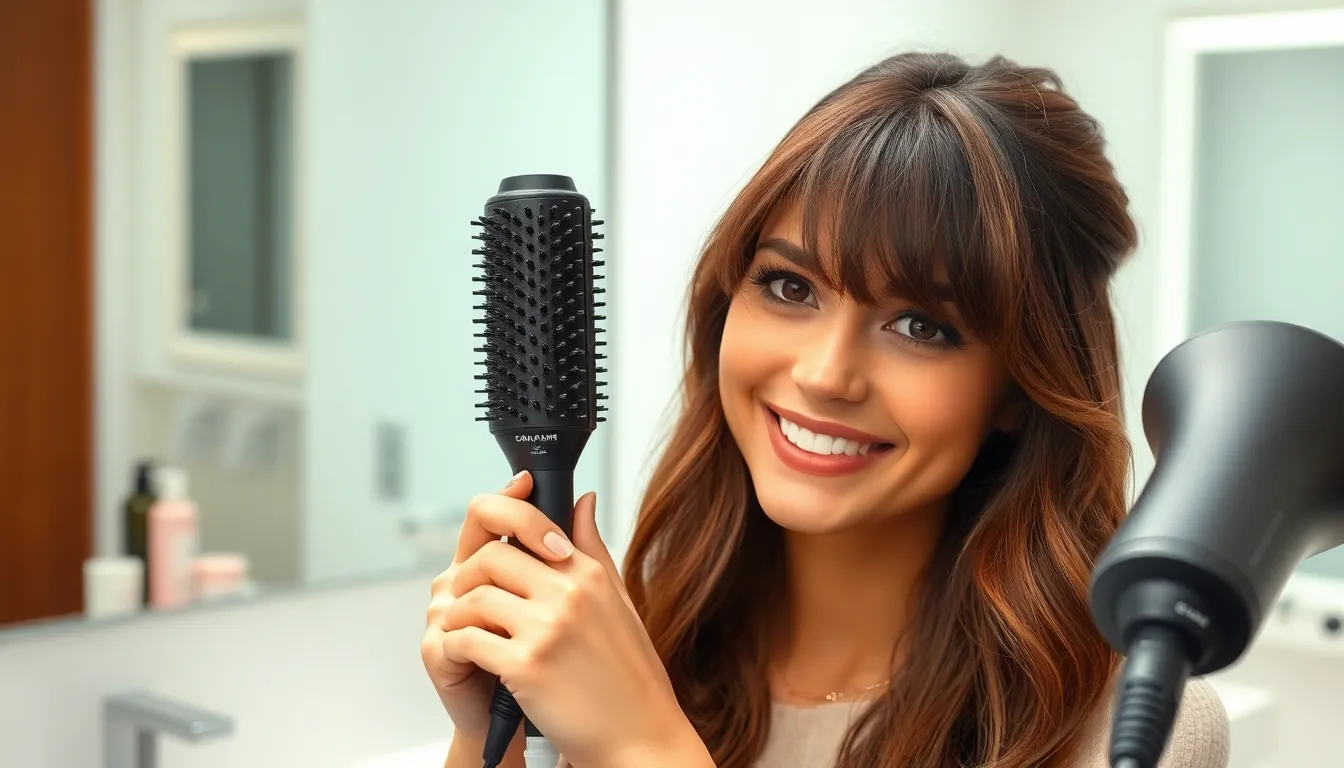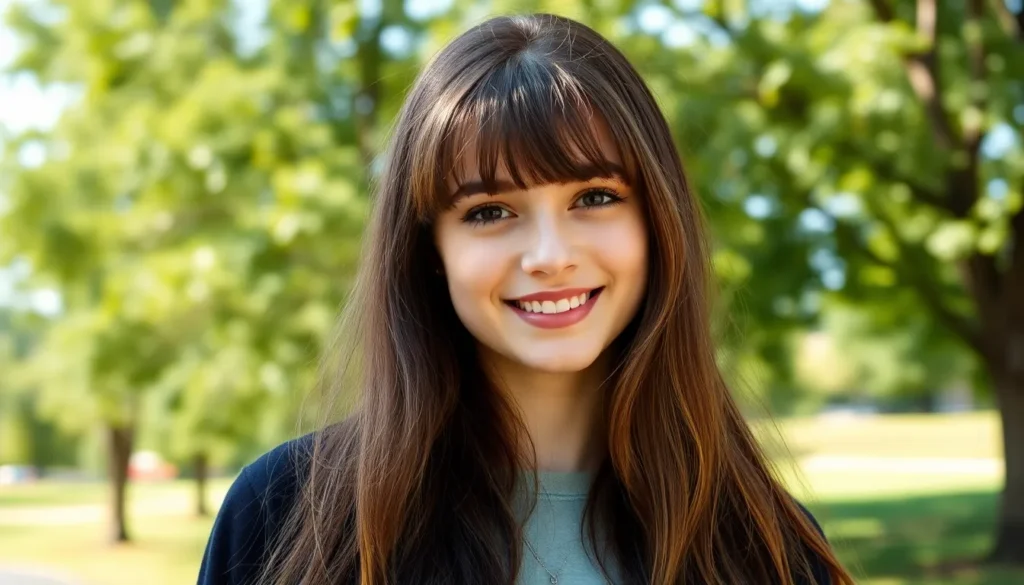We’ve all been there – staring at our reflection wondering if we should take the plunge with bangs. While blunt bangs can feel intimidating and high-maintenance, wispy bangs offer the perfect compromise between style and versatility that’s captured the hearts of celebrities and everyday fashion enthusiasts alike.
Wispy bangs are exactly what they sound like: soft, feathery fringe pieces that gently frame your face without the harsh lines of traditional bangs. They’re lighter, more textured, and infinitely more forgiving than their heavier counterparts. Whether you’ve got a round face, square jawline, or anything in between, these delicate strands work harmoniously with virtually every face shape.
What makes wispy bangs truly irresistible is their effortless maintenance and styling flexibility. Unlike thick bangs that demand daily attention, these airy wisps can air-dry beautifully and transition seamlessly from casual day looks to elegant evening styles. We’ll explore everything you need to know about achieving and maintaining this coveted hairstyle.
What Are Wispy Bangs and Why Are They So Popular?
Wispy bangs represent a soft, textured approach to face-framing hair that’s captured the attention of style enthusiasts worldwide. Their popularity stems from their incredible versatility and flattering nature across different face shapes.
Defining the Wispy Bang Look
Wispy bangs feature thin, delicate strands that create a feathery, textured appearance across the forehead. Unlike their blunt counterparts, these bangs are cut with razor techniques or point cutting to achieve their signature airy quality. The lengths typically vary from eyebrow-grazing to slightly shorter, with pieces that naturally separate and move with subtle layers.
Key characteristics include:
- Textured edges that appear naturally uneven and soft
- Varying lengths within the fringe for dimensional movement
- Sparse coverage that allows glimpses of forehead skin
- Flexible styling that works with straight, wavy, or curly hair textures
Stylists often thin out regular bangs using texturizing shears to create this effortless, lived-in appearance. The technique removes bulk while maintaining length variation that prevents the harsh line associated with traditional straight-across cuts.
Celebrity Influence on Wispy Bang Trends
Celebrity endorsement has significantly boosted wispy bangs into mainstream popularity across social media platforms and red carpet events. Stars like Billie Eilish, Taylor Swift, and Hailey Bieber have showcased various interpretations of this style, demonstrating its adaptability to different hair colors and face shapes.
Notable celebrity wispy bang moments include:
| Celebrity | Style Variation | Impact |
|---|---|---|
| Billie Eilish | Curtain wispy bangs | Popularized among Gen Z audiences |
| Taylor Swift | Side-swept wispy fringe | Mainstream adoption in pop culture |
| Hailey Bieber | Micro wispy bangs | Influenced minimalist beauty trends |
Social media platforms like TikTok and Instagram have amplified these celebrity looks through tutorials and transformations. Professional stylists credit celebrity influence for the 40% increase in wispy bang requests at salons nationwide during 2025. The hashtag #wispybangs has generated over 2 million posts, showcasing countless variations and styling techniques that keep this trend fresh and evolving.
Face Shapes That Work Best With Wispy Bangs

Wispy bangs complement most face shapes thanks to their versatile, feathery texture. We’ll explore how this soft fringe style enhances different facial structures.
Oval Face Shapes and Wispy Bangs
Oval faces benefit tremendously from wispy bangs since this face shape naturally accommodates most hairstyles. The balanced proportions of oval faces allow wispy bangs to frame features without overwhelming the natural symmetry. We recommend wispy bangs that hit just above the eyebrows for oval face shapes, creating an effortless look that enhances your eyes.
Styling wispy bangs on oval faces offers maximum flexibility in length and density. You can experiment with curtain style wispy bangs that part in the center or opt for side swept variations that blend seamlessly into longer layers. The forgiving nature of oval face shapes means wispy bangs will maintain their flattering effect whether they’re freshly cut or growing out between salon visits.
Round Face Shapes and Wispy Bangs
Round faces gain definition and length from strategically cut wispy bangs. The key lies in avoiding bangs that are too thick or blunt, which can emphasize the face’s width. Wispy bangs create vertical lines that help elongate round faces while the sparse coverage prevents the forehead from appearing completely hidden.
Side parted wispy bangs work exceptionally well for round face shapes because they create asymmetry that breaks up the circular appearance. We suggest keeping wispy bangs slightly longer at the outer edges to draw attention toward the temples rather than the center of the face. This technique creates the illusion of added height and makes round faces appear more oval.
Square Face Shapes and Wispy Bangs
Square faces receive important softening benefits from wispy bangs that counteract sharp jawlines and angular features. The delicate texture of wispy bangs provides a gentle contrast to strong facial structure. We recommend wispy bangs that hit at eyebrow length or slightly below to create balance with prominent jaw areas.
Layered wispy bangs complement square face shapes by adding movement and femininity around the forehead region. The irregular edges of wispy bangs help break up the geometric lines that characterize square faces. Avoid straight across wispy bangs on square faces and instead choose styles with varied lengths that create curve and flow around your facial features.
Different Types of Wispy Bangs to Consider

Selecting the perfect wispy bang style depends on your face shape and personal aesthetic preferences. Each variation offers unique benefits that can transform your overall look.
Curtain Wispy Bangs
Curtain wispy bangs create a center-parted frame that gracefully sweeps to both sides of your face. This versatile style mimics the appearance of curtains opening around your forehead, offering the softest introduction to bangs for first-time wearers.
We recommend curtain wispy bangs for oval and heart-shaped faces because they balance facial proportions naturally. The center part draws attention to your eyes while the feathery edges soften strong cheekbones or wide foreheads.
Styling curtain wispy bangs requires minimal effort with a round brush and blow dryer. Simply lift the bangs at the root while directing the ends away from your face using the brush. This technique creates the signature curved shape that defines the curtain effect.
Side-Swept Wispy Bangs
Side-swept wispy bangs offer an asymmetrical approach that adds instant sophistication to any hairstyle. This style features longer lengths on one side that gradually taper shorter toward the opposite temple, creating natural movement and dimension.
We find side-swept wispy bangs particularly flattering for round and square face shapes because they create diagonal lines across the forehead. The asymmetrical placement breaks up the width of round faces while softening angular jawlines on square faces.
Achieving the perfect side-swept look involves blow drying your bangs in the desired direction using a paddle brush. Start with damp hair and use a heat protectant spray before directing the airflow from root to tip. The key is maintaining consistent direction throughout the drying process.
Micro Wispy Bangs
Micro wispy bangs represent the most delicate variation, featuring ultra-thin strands that barely graze your eyebrows. This minimalist approach provides subtle face framing without the commitment of fuller bang styles.
We suggest micro wispy bangs for those wanting to test the waters with bangs or individuals with naturally fine hair textures. The sparse coverage allows maximum forehead visibility while still adding that coveted wispy texture around your face.
Creating micro wispy bangs requires precision cutting techniques that remove only select strands from your hairline. Your stylist will use point cutting or razor techniques to achieve the feathery texture while maintaining the minimal density that defines this style.
Hair Textures That Complement Wispy Bangs

Different hair textures interact uniquely with wispy bang cuts, requiring exact approaches to achieve the perfect feathery texture. Understanding your natural hair texture helps determine the best styling techniques and maintenance routines for long-lasting wispy bangs.
Fine Hair and Wispy Bang Styling
Fine hair naturally creates the ideal foundation for wispy bangs due to its lightweight texture and movement. Texturizing sprays work exceptionally well on fine strands, improving the airy quality that defines wispy bangs. We recommend using volumizing mousses before blow drying to prevent wispy bangs from appearing flat against the forehead.
Point cutting techniques prove most effective for fine hair, as they create natural separation without removing too much weight. Razor cutting can sometimes make fine hair appear too sparse, so stylists often prefer scissors for precision control. Regular trims every 4-6 weeks maintain the delicate texture while preventing wispy bangs from growing too heavy.
Styling products should remain lightweight to avoid weighing down fine wispy bangs. Sea salt sprays add texture without heaviness, while dry shampoos provide grip and volume between washes. Avoid heavy oils or creams that can make fine wispy bangs appear stringy or greasy.
Thick Hair Considerations
Thick hair requires strategic thinning to achieve the signature lightness of wispy bangs. Stylists use razor cutting and deep point cutting to remove bulk while creating the necessary texture. Multiple layers within the bang section help distribute weight evenly and prevent a blunt appearance.
Thinning shears play a crucial role in creating wispy bangs for thick hair, removing interior weight while maintaining length. We suggest asking your stylist to work in small sections, gradually building the desired texture rather than removing too much hair at once. This approach prevents accidentally creating gaps or uneven sections.
Styling thick wispy bangs often requires texturizing products that separate strands and reduce bulk. Clay based products work well for creating definition without adding shine, while lightweight serums can smooth frizz without weighing down the style. Blow drying with a small round brush helps lift thick wispy bangs away from the face while creating movement.
Curly Hair Adaptations
Curly hair creates unique challenges and opportunities when styling wispy bangs, as natural curl patterns can enhance the textured appearance. Dry cutting techniques work best for curly wispy bangs, allowing stylists to see how each curl will naturally fall and bounce. We recommend cutting curly wispy bangs longer than desired, as curls spring up significantly after cutting.
Moisture control becomes essential for curly wispy bangs, as frizz can disrupt the delicate texture. Leave in conditioners help maintain curl definition while preventing dryness that leads to unruly bangs. Diffusing on low heat preserves natural curl patterns while encouraging the wispy texture to develop.
Styling curly wispy bangs requires different products than straight hair textures. Curl creams enhance natural patterns while providing light hold, and anti frizz serums smooth the hair cuticle without disrupting curl formation. Scrunching with microfiber towels removes excess water while encouraging curl definition in wispy bang sections.
How to Ask Your Stylist for the Perfect Wispy Bangs

Getting wispy bangs that match your vision requires clear communication with your stylist. We’ll guide you through the essential steps to ensure you leave the salon with exactly what you want.
Bringing Reference Photos
Pictures speak louder than words when describing wispy bangs to your stylist. We recommend collecting 3-5 photos that showcase different angles and styling variations of the wispy bang look you desire. Save images from Instagram, Pinterest, or celebrity red carpet moments to create a comprehensive visual reference.
Focus on photos that highlight the exact texture and length you want. We suggest including images that show the bangs styled both fresh from the salon and in everyday situations. Choose references featuring models or celebrities with similar hair texture and face shape to yours for the most realistic expectations.
Show your stylist what you don’t want alongside your inspiration photos. We find this prevents miscommunication and helps your stylist understand your preferences more clearly. Point out exact details like the density, length, and how the bangs blend with the rest of your hair in each reference image.
Communicating Your Lifestyle Needs
Share your daily routine and styling habits with your stylist before the cut begins. We emphasize discussing how much time you typically spend on your hair each morning and your comfort level with styling tools. Tell your stylist if you’re a wash and go person or someone who enjoys spending 20 minutes perfecting your look.
Mention your hair washing frequency since wispy bangs behave differently on day one versus day three hair. We recommend being honest about whether you prefer low maintenance styles or don’t mind daily touch ups. Discuss your work environment and any activities that might affect how your bangs look throughout the day.
Explain your experience level with bang styling if you’re new to fringe hairstyles. We suggest asking your stylist to demonstrate the styling process during your appointment so you can replicate it at home. Request exact product recommendations that align with your lifestyle and budget constraints.
Understanding Maintenance Requirements
Schedule your next trim appointment before leaving the salon since wispy bangs require regular upkeep. We recommend booking maintenance appointments every 4-6 weeks to preserve the delicate, textured appearance of your wispy bangs. Ask your stylist about the exact timeline for your hair growth rate and desired length.
Discuss the styling products you’ll need to maintain your wispy bangs at home. We suggest asking for a complete product rundown including texturizing sprays, lightweight mousses, and any heat protectants your stylist recommends. Request demonstrations of application techniques to ensure you’re using products correctly.
Learn the warning signs that indicate when your bangs need professional attention. We advise asking your stylist to explain how to identify when your wispy bangs are losing their shape or becoming too heavy. Understand which styling challenges you can handle at home versus when you should book an emergency trim appointment.
Styling Tips for Maintaining Wispy Bangs at Home

Maintaining wispy bangs requires consistent care and the right approach between salon appointments. We’ll show you proven techniques that keep your bangs looking fresh and perfectly textured every day.
Essential Tools and Products
Round brush selection forms the foundation of effective wispy bang styling. We recommend a 1-inch ceramic round brush for most hair types, as it provides optimal control while creating lift and movement. Fine-bristled brushes work better for delicate wispy textures compared to paddle brushes that can flatten the airy quality.
Blow dryer attachments significantly impact your styling results. We suggest using a concentrator nozzle to direct airflow precisely along your bangs, preventing frizz and maintaining the feathery texture. Diffuser attachments work well for naturally curly hair textures that need gentle drying.
Texturizing spray products enhance the natural movement in wispy bangs. We prefer lightweight formulas that add grip without weighing down fine strands. Sea salt sprays create subtle texture, while volumizing mousses boost lift at the roots for fuller-looking bangs.
Styling scissors prove essential for minor touch-ups between appointments. We recommend investing in professional-grade hairdressing scissors rather than household scissors that can create blunt cuts and damage hair cuticles.
Daily Styling Techniques
Morning routine optimization starts with slightly damp hair for best results. We suggest misting your bangs with water or a lightweight leave-in conditioner before styling, as completely dry hair resists shaping and can appear stiff.
Blow drying technique requires exact directional movements to maintain wispy texture. We recommend lifting bangs straight up while blow drying, then sweeping them to your preferred side while the hair cools. This method creates natural volume and prevents flat, lifeless bangs.
Finger styling methods work effectively for quick touch-ups throughout the day. We use gentle scrunching motions with clean fingertips to revive texture, avoiding heavy-handed manipulation that can disrupt the delicate bang structure.
Product application timing affects the final appearance significantly. We apply texturizing products to damp hair before blow drying, then finish with a light mist of flexible hold hairspray to lock in the style without creating stiffness.
Managing Growth Between Salon Visits
Trimming guidelines help extend time between professional appointments safely. We recommend trimming only the longest pieces that fall below your desired length, cutting vertically rather than horizontally to maintain the textured edge characteristic of wispy bangs.
Growth pattern awareness helps you anticipate styling challenges. We notice that wispy bangs typically grow unevenly, with center pieces often growing faster than side sections, requiring strategic spot trimming every 2-3 weeks.
Styling adjustments accommodate natural growth progression effectively. We suggest gradually shifting your part slightly to one side as bangs grow out, creating a more side-swept appearance that looks intentional rather than overgrown.
Emergency fixes address common growth-related issues between appointments. We use dry shampoo to absorb excess oils that make growing bangs appear stringy, and bobby pins to temporarily section away pieces that become too long or unruly.
Common Mistakes to Avoid With Wispy Bangs

Even experienced stylists acknowledge that wispy bangs require careful maintenance and styling to achieve their signature delicate appearance. We’ve identified the most frequent errors that can sabotage your wispy bang goals.
Over-Trimming at Home
Cutting too much length represents the biggest mistake people make with wispy bangs maintenance. We see clients who attempt to recreate salon results at home, only to end up with choppy, uneven bangs that lose their wispy texture entirely.
Trimming without proper technique destroys the graduated lengths that create wispy bangs’ signature movement. Professional stylists use point cutting and razor techniques to achieve those feathery ends, while home scissors create blunt cuts that eliminate the textured appearance.
Daily trimming attempts indicate panic about growth, but wispy bangs actually need strategic length variation to maintain their airy quality. We recommend waiting 3-4 weeks between professional trims and resisting the urge to snip individual strands that seem “too long.”
Emergency fixes should focus on styling rather than cutting when your bangs look off. Texturizing spray and strategic blow drying can often restore the wispy appearance without permanent damage from hasty trimming decisions.
Using Wrong Styling Products
Heavy creams and oils weigh down the delicate strands that make wispy bangs special. We’ve observed that products designed for thick, coarse hair completely flatten the textured movement that defines this style.
Alcohol-based gels create stiffness that contradicts wispy bangs’ natural, effortless appearance. These products cause individual strands to clump together, eliminating the separated, feathery texture you’re trying to achieve.
Volumizing mousses applied incorrectly can make wispy bangs look frizzy and uncontrolled. We recommend applying lightweight texturizing sprays to damp hair instead, focusing on the mid-lengths and ends rather than the roots.
Wrong hold strength products either provide too little control, leaving bangs limp, or too much grip, making them appear helmet-like. Light-hold texturizing sprays and flexible styling creams work best for maintaining wispy bangs’ natural movement throughout the day.
Ignoring Your Natural Hair Growth Pattern
Fighting against cowlicks creates constant styling frustration and unnatural-looking results. We always assess clients’ natural growth patterns before cutting wispy bangs, as working with these patterns produces more manageable and authentic-looking styles.
Cutting against the grain of your hair’s natural direction makes wispy bangs stick up or lay flat in unwanted ways. Professional stylists follow your hair’s natural growth direction when creating the graduated lengths that give wispy bangs their signature texture.
Styling in opposition to growth patterns requires excessive heat and product to maintain, leading to damage and an artificial appearance. We teach clients to work with their natural hair movement, using it to enhance rather than fight the wispy effect.
Ignoring double crowns and unusual growth directions results in uneven wear patterns where some sections of your bangs behave differently than others. Understanding these patterns allows for customized cutting and styling approaches that maintain consistency across your entire bang area.
Wispy Bangs for Different Hair Colors and Lengths

Wispy bangs adapt beautifully to different hair colors and lengths, creating unique effects that enhance your natural features. Color and length work together to determine how visible and dramatic your wispy bangs appear.
Blonde Hair and Wispy Bangs
Blonde hair showcases wispy bangs with exceptional clarity due to the light color contrast against most skin tones. Fair hair creates a soft, ethereal effect where individual strands catch light naturally, emphasizing the delicate texture we love about this style. Platinum and ash blonde shades make wispy bangs appear almost translucent, creating an ultra-modern look that photographers and stylists frequently feature in editorial spreads.
Golden and honey blonde tones provide warmth that complements wispy bangs beautifully, especially when styled with subtle layering techniques. These warmer blonde shades work exceptionally well with curtain wispy bangs, as the color variation adds dimension to the face-framing effect. Maintenance becomes slightly easier with blonde hair since growth lines blend more seamlessly, allowing you to extend time between professional trims by 1-2 weeks compared to darker colors.
Brunette and Dark Hair Options
Brunette hair creates striking contrast with wispy bangs, making them appear more defined and intentional against darker backgrounds. Deep brown and black hair colors showcase the textural elements of wispy bangs dramatically, with each feathered strand creating distinct lines that frame facial features boldly. Chocolate brown shades offer the perfect middle ground, providing definition while maintaining softness in the overall appearance.
Rich mahogany and espresso tones enhance the sophisticated appeal of side-swept wispy bangs, particularly when combined with subtle highlighting techniques around the face. Auburn and chestnut browns add warmth that complements the organic, lived-in quality of wispy bangs perfectly. Dark hair requires more frequent touch-ups since growth becomes visible more quickly, with most clients needing professional maintenance every 3-4 weeks to keep the wispy effect looking fresh.
Short vs Long Hair Combinations
Short hair pairs exceptionally well with wispy bangs, creating balanced proportions that don’t overwhelm petite facial features. Pixie cuts and bob hairstyles benefit from the soft contrast that wispy bangs provide, preventing the overall look from appearing too severe or geometric. Short haircuts allow wispy bangs to become a focal point, with the reduced hair volume directing attention to the delicate fringe work around the face.
Medium length hair offers the most versatility for wispy bang styling, providing enough weight to support various bang densities while maintaining movement and flow. Shoulder-length cuts create harmony between the wispy texture of the bangs and the body of the hair, establishing a cohesive style that works for both casual and formal occasions.
Long hair creates dramatic contrast with wispy bangs, offering a striking juxtaposition between the substantial length and delicate fringe detail. Lengthy styles require careful consideration of proportions, as heavy hair can sometimes overwhelm very sparse wispy bangs, making slightly fuller versions more flattering. Long-haired clients often find that curtain wispy bangs work best, as they create a gradual transition from the light fringe to the fuller hair lengths.
Seasonal Styling Variations for Wispy Bangs

Different seasons bring unique challenges for maintaining the perfect wispy bang texture, but with the right adjustments, you can keep them looking effortlessly beautiful year-round.
Summer Heat and Humidity Management
Humidity poses the biggest threat to wispy bangs during summer months, causing them to lose their delicate texture and become heavy or frizzy. We recommend starting your morning routine with an anti-humidity primer like Living Proof No Frizz Instant De-Frizzer, which creates a protective barrier against moisture.
Lightweight dry shampoos become essential during hot weather, absorbing excess oil without weighing down the feathery strands. Products like Batiste Tropical Dry Shampoo offer dual benefits of oil control and subtle texture enhancement. Apply these products before stepping outside to prevent sweat and humidity from compromising your style.
Strategic blow drying techniques help lock in your desired shape before facing summer elements. We suggest using a cool setting on your blow dryer with a small round brush, directing airflow downward to seal the hair cuticle. This method creates a smoother surface that resists humidity penetration.
Swimming and beach activities require special protection for wispy bangs. Apply a leave-in conditioner with UV protection like Bumble and Bumble Hairdresser’s Invisible Oil before getting wet. This creates a protective coating that prevents chlorine and salt water from disrupting your bang texture.
Winter Static and Dryness Answers
Cold weather and indoor heating systems create static electricity that makes wispy bangs fly away from your face, disrupting their soft framing effect. Combat this issue by incorporating hydrating products into your routine, starting with a moisture-rich leave-in treatment like Moroccanoil Treatment Light.
Static occurs when hair lacks moisture, so we recommend using a humidifier in your bedroom to maintain optimal air moisture levels. Target humidity levels between 40-50% to prevent both static buildup and excessive dryness that can make wispy bangs appear brittle.
Natural fiber brushes work better than synthetic ones during winter months for styling wispy bangs. Boar bristle brushes distribute natural oils more effectively and generate less static than plastic alternatives. Keep one of these brushes at your desk for quick touch-ups throughout the day.
Fabric softener sheets provide an emergency static solution when you’re away from home. Gently run a dryer sheet over your bangs to neutralize electrical charge, but use this method sparingly as frequent application can cause product buildup.
Winter styling products should focus on moisture retention without heaviness. We prefer silicone-free serums like DevaCurl SuperCream Coconut Curl Styler, which provides hydration while maintaining the airy quality essential to wispy bangs.
Transitional Season Adjustments
Spring brings unpredictable weather patterns that require flexible styling approaches for wispy bangs. Layering lightweight products allows you to adjust protection levels based on daily conditions. Start with a heat protectant base, add texturizing spray for humid days, or incorporate anti-static products when dry winds appear.
Fall transitions demand preparation for upcoming winter dryness while managing lingering summer humidity. We suggest gradually introducing more moisturizing products into your routine during September and October. This prevents shock to your hair system while building up protective barriers.
Seasonal hair growth patterns affect wispy bang maintenance schedules during transitional periods. Hair typically grows faster during spring and summer months, requiring more frequent trims every 3-4 weeks. Fall and winter growth slows down, allowing 5-6 weeks between professional touch-ups.
Weather tracking apps help predict styling needs for wispy bangs during unpredictable transitional seasons. Check humidity levels each morning to determine whether you need lightweight or moisture-rich products. Temperatures above 70°F with humidity over 60% call for anti-frizz primers, while cooler, drier days benefit from hydrating leave-in treatments.
Product rotation becomes crucial during seasonal transitions to prevent buildup while addressing changing environmental needs. We recommend having summer, winter, and transitional product sets ready, switching between them based on weekly weather forecasts rather than calendar dates.
When Wispy Bangs Might Not Be Right for You

While wispy bangs offer versatility and style, they’re not universally flattering or practical for every lifestyle. Understanding potential limitations helps you make an well-informed choice about this trendy hairstyle.
High-Maintenance Lifestyle Considerations
Frequent touch ups become necessary when your schedule leaves little time for styling. Wispy bangs require daily attention to maintain their textured, airy appearance, often needing 10-15 minutes of focused styling each morning.
Travel complications arise when you can’t access your usual styling tools and products. Hotels rarely provide the exact brushes or texturizing sprays needed to recreate your salon look, leaving you with flat or unruly bangs during important trips.
Exercise routines that involve intense sweating or swimming can disrupt wispy bang styling within hours. Gym sessions, hot yoga classes, and pool activities require complete restyling afterward, making this cut impractical for fitness enthusiasts.
Busy mornings don’t accommodate the patience required for proper bang styling. Parents rushing children to school, commuters catching early trains, or shift workers often find themselves skipping bang maintenance, resulting in unkempt appearance.
Professional Environment Requirements
Conservative workplace policies may view wispy bangs as too casual or trendy for formal business settings. Law firms, financial institutions, and corporate environments often prefer more traditional, polished hairstyles that project authority and professionalism.
Client facing roles in industries like real estate, consulting, or sales require consistent, professional appearance that wispy bangs might undermine. Clients may perceive textured, deliberately messy bangs as unprofessional or youthful.
Uniform requirements in healthcare, hospitality, or service industries often mandate hair be pulled back completely. Nurses, restaurant servers, and retail workers find wispy bangs create hygiene concerns or interfere with required headwear.
Camera appearances for news anchors, corporate speakers, or video conference presentations can make wispy bangs appear unflattering under studio lighting. Television cameras often emphasize texture irregularities, creating distracting shadows across the forehead.
Hair Growth Pattern Challenges
Stubborn cowlicks at the hairline make wispy bang styling nearly impossible without extensive daily manipulation. Natural growth whorls create persistent directions that fight against the intended bang flow, requiring professional intervention every 2-3 weeks.
Uneven growth rates across the forehead create lopsided bangs that lose their intended wispy texture. Some hair follicles grow faster than others, causing sections to become too long while others remain appropriately textured.
Double crowns or multiple growth patterns create competing directional pulls that prevent wispy bangs from laying smoothly. These natural growth anomalies make consistent styling extremely difficult and often result in perpetually messy appearance.
Naturally oily scalp conditions cause wispy bangs to become greasy and clumpy within hours of styling. Excess sebum production weighs down the delicate texture, eliminating the airy quality that defines this cut and requiring daily washing to maintain appearance.
Conclusion
Wispy bangs continue to prove their staying power as one of the most adaptable and flattering hairstyle choices available today. We’ve seen how this versatile style transcends traditional beauty boundaries while offering endless customization possibilities for every hair type and lifestyle.
The key to wispy bang success lies in understanding your unique hair characteristics and working with a skilled stylist who can tailor the cut to your exact needs. With proper care seasonal adjustments and the right styling approach you’ll discover why this trend has captured the attention of celebrities and everyday style enthusiasts alike.
Whether you’re ready to take the plunge or still weighing your options remember that great hair is an investment in your confidence and personal style.
Frequently Asked Questions
What are wispy bangs and how do they differ from regular bangs?
Wispy bangs feature thin, delicate strands that create a soft, feathery texture with textured edges and varying lengths. Unlike blunt bangs that create harsh lines, wispy bangs offer sparse coverage with dimensional movement, allowing glimpses of the forehead. They’re achieved through techniques like razor cutting or point cutting to create their characteristic airy appearance.
Which face shapes work best with wispy bangs?
Wispy bangs are versatile and complement most face shapes. Oval faces can wear various styles including curtain or side-swept bangs. Round faces benefit from side-parted wispy bangs that create vertical lines and elongate the face. Square faces are softened by wispy bangs that counteract sharp jawlines, with layered styles adding movement and femininity.
How often should I trim my wispy bangs?
Professional trims should be scheduled every 3-4 weeks to maintain the delicate texture and shape of wispy bangs. Over-trimming at home can lead to choppy, uneven results that lose their feathery appearance. Between salon visits, minor adjustments can be made, but major trimming should be left to professionals.
What styling products work best for wispy bangs?
Use lightweight texturizing sprays and flexible styling creams to maintain the airy quality of wispy bangs. Avoid heavy products like thick creams or alcohol-based gels that can weigh down the delicate strands. For fine hair, volumizing mousses help enhance texture, while thick hair benefits from thinning serums.
Can wispy bangs work with curly or thick hair?
Yes, but they require specialized techniques. Thick hair needs strategic thinning and layering to achieve the characteristic lightness. Curly hair works best with dry cutting techniques and moisture control products. Both textures benefit from professional styling to maintain the wispy effect without losing the hair’s natural properties.
How do I style wispy bangs at home?
Use a 1-inch ceramic round brush and blow dryer with a concentrator nozzle for precision styling. Blow dry bangs forward while lifting at the roots for volume, then finger-style for natural movement. Daily maintenance includes light brushing and touch-ups with texturizing spray to maintain their fresh appearance.
Are wispy bangs high maintenance?
Wispy bangs require moderate maintenance including daily styling, regular professional trims, and proper product selection. They need protection from humidity in summer and extra moisture in winter. While not extremely high-maintenance, they do require consistent care to maintain their signature soft, feathery texture and shape.
What are the different types of wispy bangs?
The main types include curtain wispy bangs that frame the face with a center part (ideal for oval and heart-shaped faces), side-swept wispy bangs that add sophistication (flattering for round and square faces), and micro wispy bangs offering the most delicate, minimalist approach for those wanting subtle fringe.


















